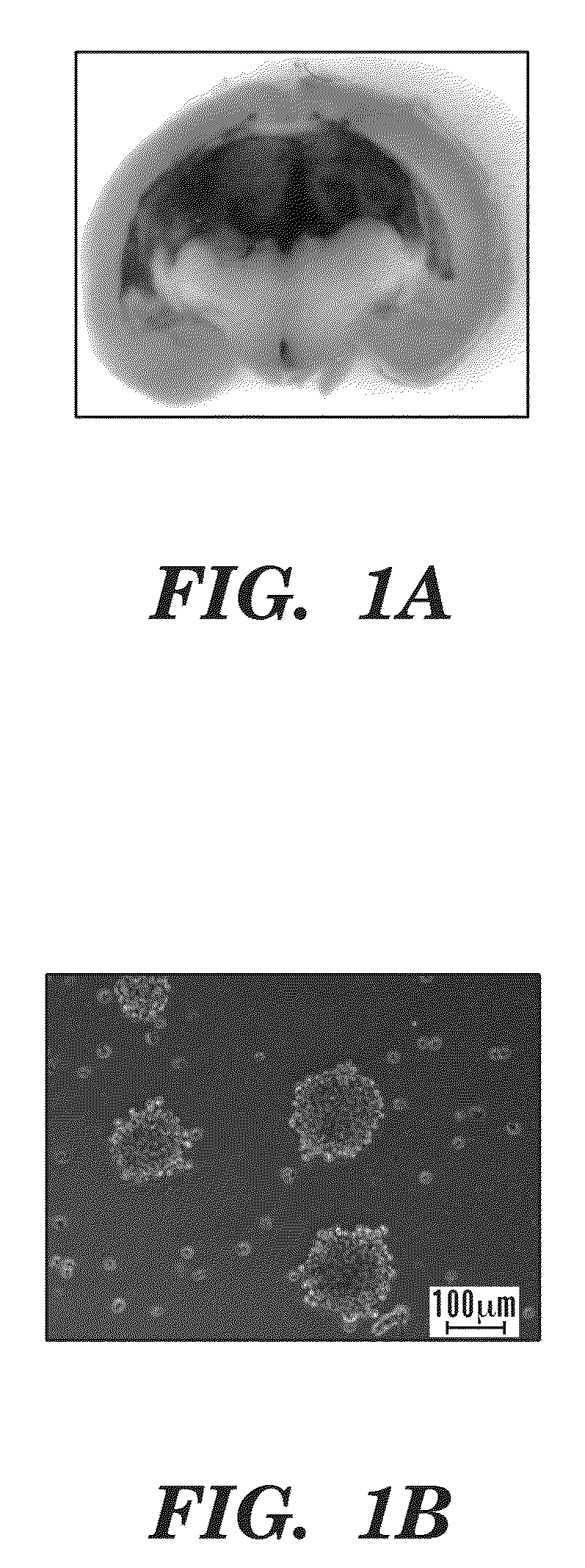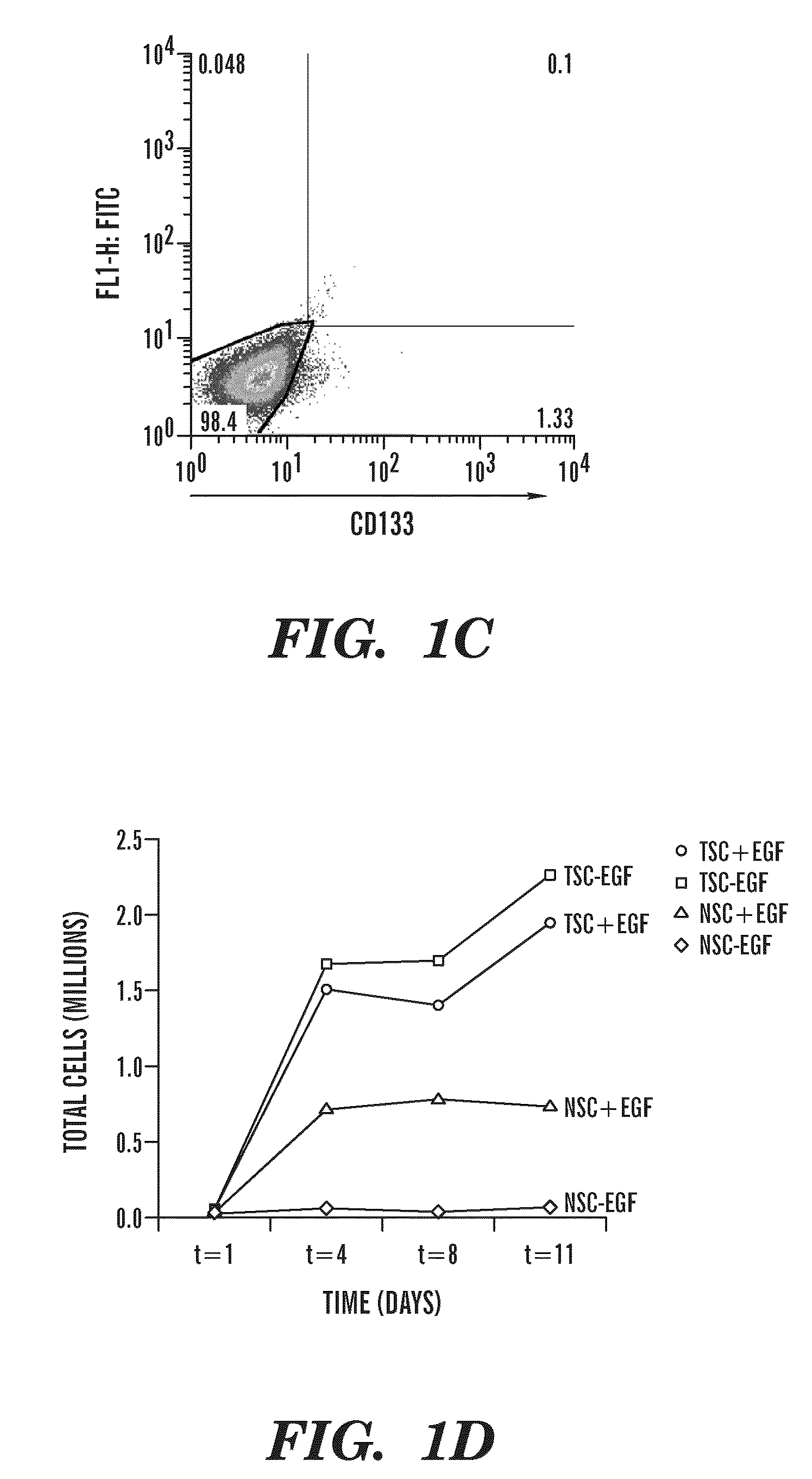Diagnostic and prognosis methods for cancer stem cells
a cancer stem cell and prognostic method technology, applied in the direction of nucleotide libraries, instruments, drug compositions, etc., can solve the problems of ineffective available therapies against many cancers, difficult prospective isolation of cscs from mouse models of cancer, and no validated biomarker or biomarker for cancer stem cell populations, etc., to improve diagnosis accuracy.
- Summary
- Abstract
- Description
- Claims
- Application Information
AI Technical Summary
Benefits of technology
Problems solved by technology
Method used
Image
Examples
example 1
[0276]To identify CSC in mouse cancer models, the inventors used a transgenic mouse model of oligodendroglioma in which the S100β-promoter drives the expression of the verbB gene (10). In the Trp53− / − (p53− / −) mutant background, S100β-verbB;p53− / − animals develop “spontaneous”, oligodendrogliomas (FIG. 1A) that faithfully recapitulate the human disease at high frequency. Unlike transplanted neoplasms from xenografted human brain cancer cell lines, brain tumors in S100β-verbB;p53− / − animals are highly infiltrative, aggressive oligodendrogliomas with extensive vascularization and necrosis (data not shown). Hence, this animal model (maintained on an inbred genetic background) provides an excellent opportunity to test whether mouse primary brain tumors contain cancer stem cells, like human brain tumors and importantly, to determine the molecular differences between normal and cancer stem cells of the nervous system.
[0277]To identify distinguishing cellular phenotypes of normal and cance...
example 2
[0279]Another defining characteristic of cancer stem cells is that they initiate a tumor when transplanted in a suitable host. Tumorsphere cells isolated from multiple independent tumors generate neoplasms that resemble the original tumor 100% of the time when injected into NOD.CB17-Prkdcscid / J (NOD-SCID) immune-deficient mice or C57BL / 6J wildtype mice (Table 1). Even injections of individual tumorspheres (consisting of approximately 100-200 cells) consistently gave rise to rapid tumor formation (less than 4 weeks), suggesting that each tumorsphere contains at least one cancer initiating cell (shown for 3447 in Table 1). Histological analysis and molecular marker expression (data not shown) show identical expression patterns between primary and secondary (injected) tumors. These tumors can be serially transferred through animals over multiple passages (>6 passages), demonstrating in vivo self-renewal ability. At each passage, tumorspheres were isolated and characterized. These tumor...
example 3
[0282]For future development of targeted therapeutics against cancer stem cells, understanding the molecular difference between cancer stem cells and normal stem cells and non-stem cancer cells is absolutely essential. To identify genes that distinguish cancer stem cells from normal stem cells, SP and non-SP cells were isolated from neurospheres (derived from S100β-verbB;p53− / − and p53− / − control animals) and tumorspheres (derived from two independent brain tumors in S100β-verbB;p53− / − animals) (data not shown). SP and non-SP cells were directly sorted into a lysis buffer at the time of sorting to fix the both cellular state as well as genetic background in this transcriptome comparison. Labeled probes were prepared from these cDNA and hybridized onto MOUSE430—2 Affymetrix GeneChip arrays. 538 significantly differentially expressed genes showed consistent gene expression differences between the two independent cancer SP and normal SP populations (q-value1.5) (data not shown). 345 ge...
PUM
| Property | Measurement | Unit |
|---|---|---|
| nucleic acid | aaaaa | aaaaa |
| time | aaaaa | aaaaa |
| binding affinity | aaaaa | aaaaa |
Abstract
Description
Claims
Application Information
 Login to View More
Login to View More - R&D
- Intellectual Property
- Life Sciences
- Materials
- Tech Scout
- Unparalleled Data Quality
- Higher Quality Content
- 60% Fewer Hallucinations
Browse by: Latest US Patents, China's latest patents, Technical Efficacy Thesaurus, Application Domain, Technology Topic, Popular Technical Reports.
© 2025 PatSnap. All rights reserved.Legal|Privacy policy|Modern Slavery Act Transparency Statement|Sitemap|About US| Contact US: help@patsnap.com



